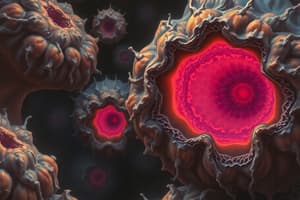Podcast
Questions and Answers
What happens to cells when a tumour forms?
What happens to cells when a tumour forms?
- They divide and multiply uncontrollably (correct)
- They repair and regenerate normally
- They stop growing and multiplying
- They become dormant and inactive
What evidence in Figure 1 suggests that the lung tumour is malignant?
What evidence in Figure 1 suggests that the lung tumour is malignant?
- Well-defined shape and slow growth
- Smooth edges and limited growth
- Uniform texture and non-invasive growth
- Irregular shape and invasive growth (correct)
Why might a person with certain types of cancer experience symptoms like tiredness, frequent infections, and uncontrollable bleeding?
Why might a person with certain types of cancer experience symptoms like tiredness, frequent infections, and uncontrollable bleeding?
- Enhanced immune system response to infections
- High levels of blood components causing fatigue
- Increased energy levels due to cellular changes
- Low numbers of blood components causing poor immunity and abnormal bleeding (correct)
What is the purpose of a blood transfusion?
What is the purpose of a blood transfusion?
Why is it dangerous for a patient with blood group A to receive red blood cells from a donor with blood group B?
Why is it dangerous for a patient with blood group A to receive red blood cells from a donor with blood group B?
Why can blood group O red blood cells be given to patients with any blood group?
Why can blood group O red blood cells be given to patients with any blood group?
Which risk associated with blood transfusions has the lowest probability of occurring?
Which risk associated with blood transfusions has the lowest probability of occurring?
Flashcards are hidden until you start studying
Study Notes
Tumour Formation
- When a tumour forms, cells divide uncontrollably and accumulate, leading to a mass of abnormal cells.
Identifying Malignant Tumours
- Figure 1 suggests the lung tumour is malignant due to the presence of abnormal cell shapes, sizes, and nuclei.
Cancer Symptoms
- Cancer can cause symptoms like tiredness, frequent infections, and uncontrollable bleeding due to the suppression of the immune system and destruction of healthy blood cells.
Blood Transfusions
- The purpose of a blood transfusion is to transfer blood or blood products from a donor to a patient to replace blood lost due to surgery, injury, or disease.
Blood Group Compatibility
- It is dangerous for a patient with blood group A to receive red blood cells from a donor with blood group B because the patient's immune system will react to the foreign antigens, leading to a severe reaction.
Universal Donors
- Blood group O red blood cells can be given to patients with any blood group because they lack A and B antigens, reducing the risk of an immune response.
Blood Transfusion Risks
- The risk with the lowest probability of occurring during blood transfusions is a viral transmission, such as HIV or hepatitis.
Studying That Suits You
Use AI to generate personalized quizzes and flashcards to suit your learning preferences.




